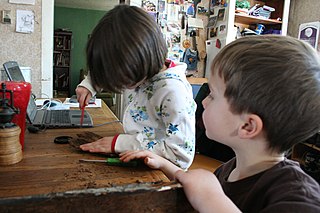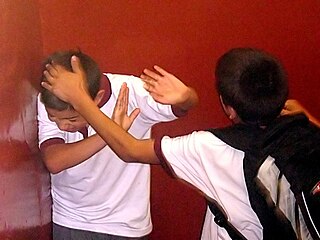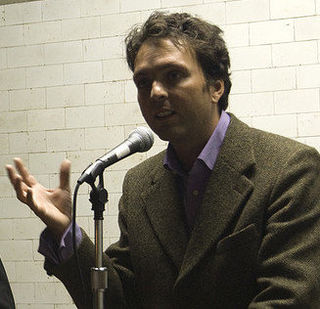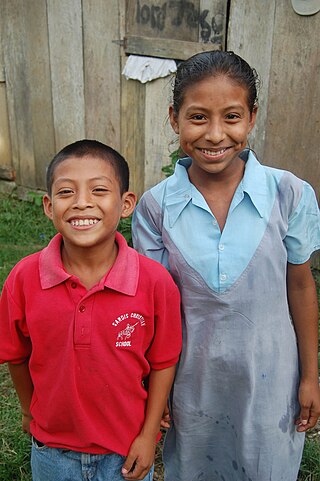
Parenting or child rearing promotes and supports the physical, cognitive, social, emotional, and educational development from infancy to adulthood. Parenting refers to the intricacies of raising a child and not exclusively for a biological relationship.

A toy or plaything is an object that is used primarily to provide entertainment. Simple examples include toy blocks, board games, and dolls. Toys are often designed for use by children, although many are designed specifically for adults and pets. Toys can provide utilitarian benefits, including physical exercise, cultural awareness, or academic education. Additionally, utilitarian objects, especially those which are no longer needed for their original purpose, can be used as toys. Examples include children building a fort with empty cereal boxes and tissue paper spools, or a toddler playing with a broken TV remote. The term "toy" can also be used to refer to utilitarian objects purchased for enjoyment rather than need, or for expensive necessities for which a large fraction of the cost represents its ability to provide enjoyment to the owner, such as luxury cars, high-end motorcycles, gaming computers, and flagship smartphones.

Unschooling is a practice of self-driven informal learning characterized by a lesson-free and curriculum-free implementation of homeschooling. Unschooling encourages exploration of activities initiated by the children themselves, under the belief that the more personal learning is, the more meaningful, well-understood, and therefore useful it is to the child.

Teasing has multiple meanings and uses. In human interactions, teasing exists in three major forms: playful, hurtful, and educative. Teasing can have a variety of effects, depending on how it is used and its intended effect. When teasing is unwelcome, it may be regarded as harassment or mobbing, especially in the workplace and school, or as a form of bullying or emotional abuse. If done in public, it may be regarded as humiliation. Teasing can also be regarded as educative when it is used as a way of informal learning. Adults in some of the Indigenous American communities often tease children to playfully illustrate and teach them how their behavior negatively affects the community. Children in many Indigenous American communities also learn by observing what others do in addition to collaborating with them. Along with teasing, this form of informal learning is different from the ways that Western American children learn. Informal ways of child learning include mutual responsibility, as well as active collaboration with adults and peers. This differentiates from the more formal way of learning because it is not adult-oriented.

Physical abuse is any intentional act causing injury or trauma to another person or animal by way of bodily contact. In most cases, children are the victims of physical abuse, but adults can also be victims, as in cases of domestic violence or workplace aggression. Alternative terms sometimes used include physical assault or physical violence, and may also include sexual abuse. Physical abuse may involve more than one abuser, and more than one victim.

Commercial Sexual Exploitation of Children (CSEC) defines the "umbrella" of crimes and activities that involve inflicting sexual abuse on to a child as a financial or personal opportunity. Commercial Sexual Exploitation consists of forcing a child into prostitution, sex trafficking, early marriage, child sex tourism and any other venture of exploiting children into sexual activities. According to the Office of Juvenile Justice and Delinquency Prevention, the lack of reporting the crime and "the difficulties associated with identifying and measuring victims and perpetrators" has made it almost impossible to create a national estimate of the prevalence of Commercial Sexual Exploitation of Children in the United States. There is an estimated one million children that are exploited for commercial sex globally; of the one million children that are exploited, the majority are girls.

Tom Hodgkinson is a British writer and the editor of The Idler magazine, which he established in 1993 with his friend Gavin Pretor-Pinney. His philosophy, in his published books and articles, is of a relaxed approach to life, enjoying it as it comes rather than toiling for an imagined better future. The Idler was named after a series of essays written by Dr Johnson from 1758 to 1760.

Gross motor skills are the abilities usually acquired during childhood as part of a child's motor learning. By the time they reach two years of age, almost all children are able to stand up, walk and run, walk up stairs, etc. These skills are built upon, improved and better controlled throughout early childhood, and continue in refinement throughout most of the individual's years of development into adulthood. These gross movements come from large muscle groups and whole body movement. These skills develop in a head-to-toe order. The children will typically learn head control, trunk stability, and then standing up and walking. It is shown that children exposed to outdoor play time activities will develop better gross motor skills.

Forest kindergarten is a type of preschool education for children between the ages of three and six that is held almost exclusively outdoors. Whatever the weather, children are encouraged to play, explore and learn in a forest environment. The adult supervision is meant to assist rather than lead. It is also known as Waldkindergarten, outdoor nursery, or nature kindergarten.

The role of the children in ancient Mayan civilization was first, and foremost, to help their elders. Once children turned five or six, they were expected to contribute to the family and community. They were treated as young adults and received more responsibilities as they grew older.

Informal learning is characterized "by a low degree of planning and organizing in terms of the learning context, learning support, learning time, and learning objectives". It differs from formal learning, non-formal learning, and self-regulated learning, because it has no set objective in terms of learning outcomes, but an intent to act from the learner's standpoint. Typical mechanisms of informal learning include trial and error or learning-by-doing, modeling, feedback, and reflection. For learners this includes heuristic language building, socialization, enculturation, and play. Informal learning is a pervasive ongoing phenomenon of learning via participation or learning via knowledge creation, in contrast with the traditional view of teacher-centered learning via knowledge acquisition. Estimates suggest that about 70-90 percent of adult learning takes place informally and outside educational institutions.
After-school activities, also known as after-school programs or after-school care, started in the early 1900s mainly just as supervision of students after the final school bell. Today, after-school programs do much more. There is a focus on helping students with school work but can be beneficial to students in other ways. An after-school program, today, will not limit its focus on academics but with a holistic sense of helping the student population. An after-school activity is any organized program that youth or adult learner voluntary can participate in outside of the traditional school day. Some programs are run by a primary or secondary school, while others are run by externally funded non-profit or commercial organizations. After-school youth programs can occur inside a school building or elsewhere in the community, for instance at a community center, church, library, or park. After-school activities are a cornerstone of concerted cultivation, which is a style of parenting that emphasizes children gaining leadership experience and social skills through participating in organized activities. Such children are believed by proponents to be more successful in later life, while others consider too many activities to indicate overparenting. While some research has shown that structured after-school programs can lead to better test scores, improved homework completion, and higher grades, further research has questioned the effectiveness of after-school programs at improving youth outcomes such as externalizing behavior and school attendance. Additionally, certain activities or programs have made strides in closing the achievement gap, or the gap in academic performance between white students and students of color as measured by standardized tests. Though the existence of after-school activities is relatively universal, different countries implement after-school activities differently, causing after-school activities to vary on a global scale.
Positive discipline (PD) is a discipline model used by some schools and in parenting that focuses on the positive points of behavior. It is based on the idea that there are no bad children, just good and bad behaviors. Practitioners of positive discipline believe that good behavior can be taught and reinforced while weaning bad behaviors without hurting the child verbally or physically. People engaging in positive discipline believe that they are not ignoring problems but dealing with the problem differently by helping the child learn how to handle situations more appropriately while remaining kind to the children themselves.

Play is a range of intrinsically motivated activities done for recreation. Play is commonly associated with children and juvenile-level activities, but may be engaged in at any life stage, and among other higher-functioning animals as well, most notably mammals and birds.
Concerted cultivation is a parenting style or parenting practice marked by a parent's attempts to foster their child's talents by incorporating organized activities in their children's lives. The expression is attributed to Annette Lareau. This parenting style is commonly exhibited in middle-class and upper-class American families, and is also characterized by consciously developing language use and ability to interact with social institutions. Many have attributed cultural benefits to this form of child-rearing due to the style's use in higher income families, conversely affecting the social habitus of children raised in such a manner. A child that has been concertedly cultivated will often express greater social prowess in social situations involving formality or structure attributed to their increased experience and engagement in organized clubs, sports, musical groups as well as increased experience with adults and power structure. This pattern of child rearing has been linked to an increase in financial and academic success.
The Dreyfus Model of Skill Acquisition describes distinct stages learners pass through as they acquire new skills. It has been used in fields such as education, nursing, operations research, and many more. Brothers Stuart and Hubert Dreyfus originally proposed the model in 1980 in an 18-page report on their research at the University of California, Berkeley, Operations Research Center for the United States Air Force Office of Scientific Research. The model was elaborated in more detail in their book Mind Over Machine (1986/1988). A more recent articulation, "Revisiting the Six Stages of Skill Acquisition," authored by Stuart E. Dreyfus and B. Scot Rousse, appears in a volume exploring the relevance of the Skill Model: Teaching and Learning for Adult Skill Acquisition: Applying the Dreyfus and Dreyfus Model in Different Fields (2021). The contributions to this volume attest to the wide variety of domains in which the Skill Model has been both corroborated and influential.
Physical Activity Guidelines for Americans are National Physical Activity Guidelines first published by the United States Department of Health and Human Services (HHS) in 2008. These guidelines provided physical activity recommendations for people aged six years and older, including those with many chronic health conditions and disabilities. The science-based Guidelines recommend a total amount of physical activity per week to achieve a range of health benefits. In 2018, HHS released an update to the first set of guidelines. This 2018 edition provides guidelines for people aged three years and older and summarizes the new knowledge gained from studies that were conducted since the first edition was released in 2008.
Learning through play is a term used in education and psychology to describe how a child can learn to make sense of the world around them. Through play children can develop social and cognitive skills, mature emotionally, and gain the self-confidence required to engage in new experiences and environments.

A playground, playpark, or play area is a place designed to provide an environment for children that facilitates play, typically outdoors. While a playground is usually designed for children, some are designed for other age groups, or people with disabilities. A playground might exclude children below a certain age.
Children were hidden in various different ways during the Holocaust in order to save them from the Nazis. Most were hidden in Poland, though some were hidden in Western Europe. Not all attempts to save them were successful; for instance, German Jewish refugee Anne Frank was eventually captured in Amsterdam.












